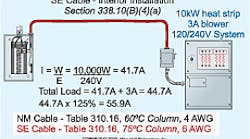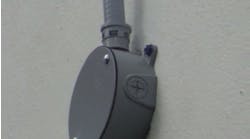Art. 340 covers the use, installation, and construction specifications of service-entrance cable (Types SE and USE). Type SE cable has a flame-retardant, moisture-resistant covering. Type USE cable, identified for underground use, has a moisture-resistant covering, but is not required to have a flame-retardant covering.
When using Type SE service-entrance cable for interior branch circuits and feeders, you must comply with the installation requirements of Parts I and II for NM cable, but not the 60°C conductor ampacity limitations noted in 334.80. The Code does not allow you to use Type USE cable for interior installations because it is not listed for this application.
The requirements of 424.3(B) requires the branch-circuit conductor for electric space heating equipment to have an ampacity of not less than 125% of the total heating load. A 10kW heater with a 3A blower motor must be wired with a conductor that has an ampacity of at least 56A. See the calculation noted in the Figure. You could use 4 AWG NM cable or 6 AWG SE cable to serve this load.





